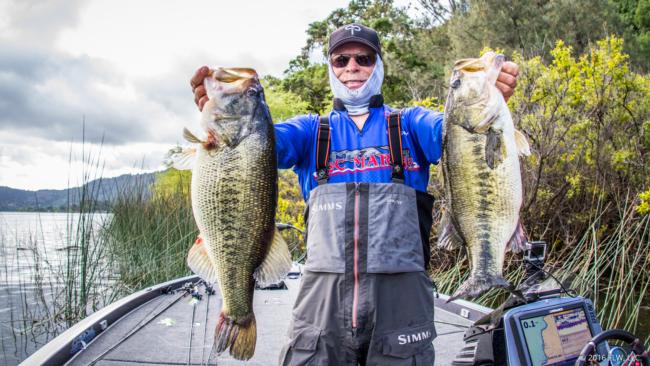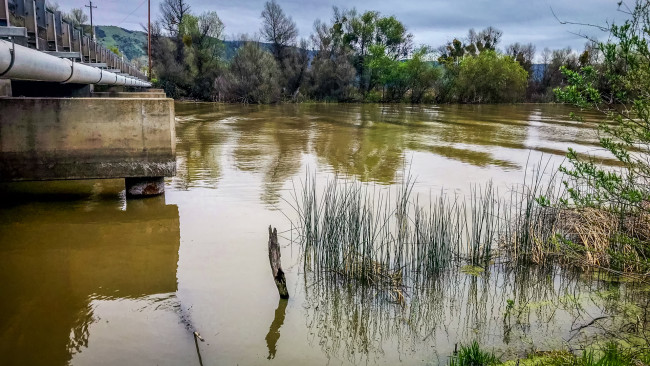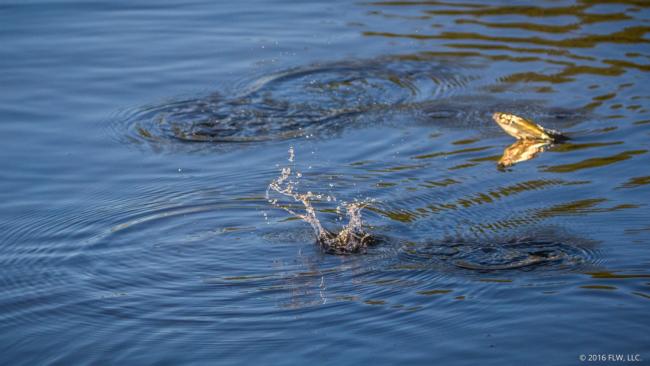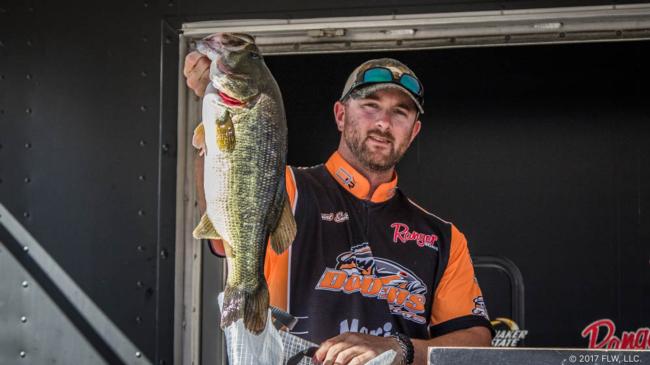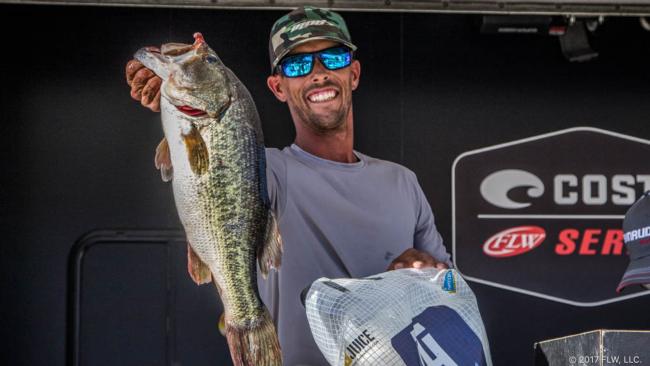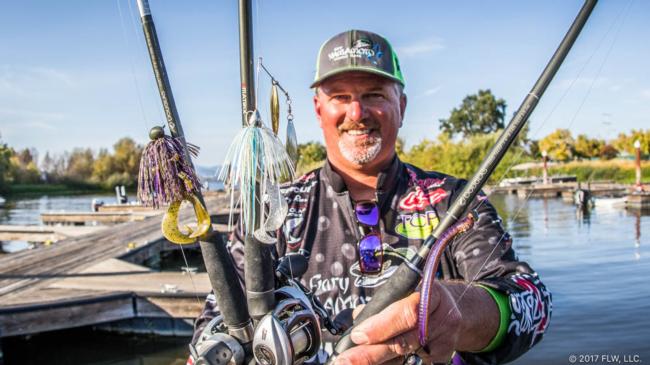Clear Lake Then and Now
What we can expect at the Costa FLW Series event following a year of wildly fluctuating weather and water levels

It was only a year ago that California was still drenched by its wettest winter in more than a century – experiencing what was called a “bombogenesis.”
Yes, that’s a real thing.
As Californians came to find out, a bombogenesis, or “weather bomb,” doesn’t halt just because it is moving across what is supposed to be “sunny California.” It dumped record rainfall in some regions, causing flooding and other headaches.
The resilient Golden State recouped only to fall back into drought conditions over most of the state for 2018, even with the appearance of April’s storms that pummeled Cali with a “potent atmospheric river.”
Yes, that’s a real thing too. We will call the atmospheric river the “A-riv.”
Researchers have dubbed California’s flood-to-drought condition a “precipitation whiplash.” Yes, that’s also a real thing now.
So, what’s all that mean for the conditions of Clear Lake, which will host the Costa FLW Series Western Division event May 10-12? Let’s find out.
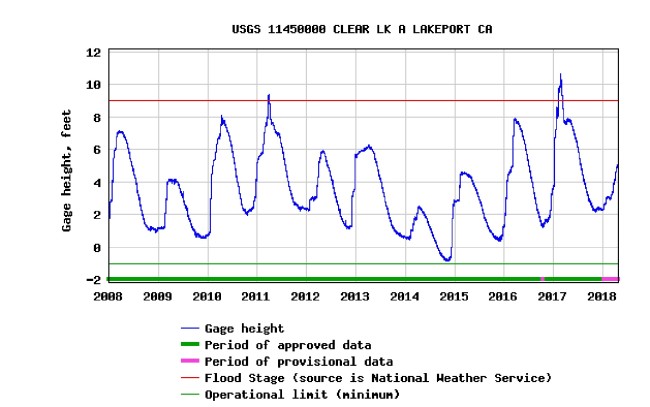
Lake levels
In 2017, Clear Lake reached its fifth-highest crest in recorded history.
Measured on the Rumsey Gauge, Feb. 22, 2017, the lake sat above 10 Rumsey – 10.63 feet. It was its highest point in a decade. A full lake is 7.56 feet, while flood stage is 9 Rumsey.
The lake currently sits at approximately 5 Rumsey. This reflects nearly a 1-foot spike that came in the 48 hours of the A-riv downpour that hit the first week of April.
The A-riv was then followed by intermittent showers throughout the month.
Lake local Paul Bailey witnessed the latest storm.
“It didn’t raise the water level much. In fact, the lake is now a little lower than before the rain,” says Bailey, who has caught just under 50 double-digit bass on the lake. “Water is being let out. It is getting warmer, so I am sure they are pulling it to get ready for the crops and orchards for spring and summer harvest.
“From this point, the lake will just keep getting lower and lower, but that will just make the bed fish easier to see.”
The spawn
Last spring, the record-high water levels spread the spawning flats back deep into the vegetation. This made it more difficult to locate bed fish. This year, with a more ordinary water level, that should be less problematic.
Bailey, a three-time top-10 finisher in FLW Clear Lake events, expects the spawners to show up in full force.
“This will be the first really big wave this year,” he said during the last full week of April, in the days leading up to a full moon. “There are a ton of ’em up now. If a guy gets on some bed fish in the event, he will be dangerous.”
Defending Clear Lake champion Bryant Smith concurs.
“Because there are so many fish in this lake, it gets six or seven big waves of spawners,” he says. “If we can get the crazy weather out of the way, they are going to come.
“By the time of FLW, there will be a lot of postspawn bass. There are already postspawners in the lake, and there will just be more and more, which will make the postspawners that are moving back out another viable pattern. It’s definitely a way to be consistent in this tournament because you will continually have fish coming to you. It’s a pattern that I will look into for sure.”
Having a back-up plan will be important even if the spawn is in full swing because bedding bass tend to get picked off pretty quickly.
“In general, spring means there will be a lot more fish up shallow, and when bed fish are up, they are always a player,” says Smith. “I enjoy looking for bed fish and catching them. They are a really good way to do well in May – at least for the first couple of days of a tournament. If they are up, it means a lot of my practice time will be spent marking beds.
“The potential is slim that bed fish will hold out the whole time on the second day or even be there at all on the last day,” he adds. “So, spending practice time fishing and not just marking beds will also be critical.”
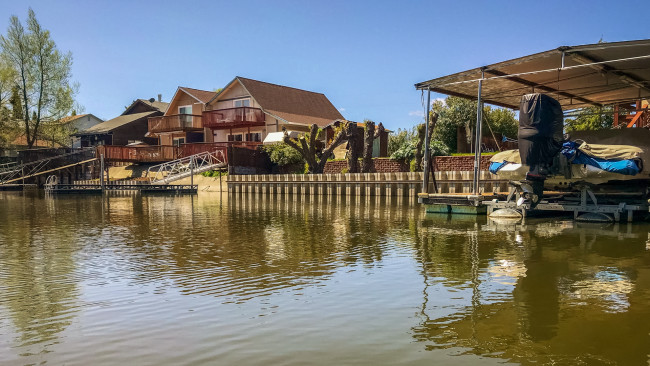
The mud river
The combination of the atmospheric river dumping significant precipitation in only a matter of days, the warmth of the rain forcing snowmelt and the limited amount of submerged grass caused an influx of relatively fast-moving water to enter the lake. The resulting current stirred up the bottom, creating a mud river that stretched from Rodman Slough to nearly mid-lake.
“It was a perfect storm with the rain washing all the silt down the sloughs that had been sitting there for all that time,” Smith says.
Although most of the lake remains stained throughout, the giant mud puddle has mostly dissipated.
Bailey says the Rodman area won’t clear up for at least three months and notes the poor visibility around the rest of the lake is a day-to-day situation.
“On days it is warmer the algae comes up even more, making it even darker,” says the local pro. “It just keeps changing and changing.
“I don’t think the dirty water affects the bite the way some people do. I think the dirty water makes the fish ‘stupider;’ so, it makes the fishing better.”
Fish food
Bailey expects a full-fledged shad spawn by the time the FLW anglers blast off.
“The last couple of years there has been a huge shad spawn,” says Bailey. “During FLW, there will be more of them up shallow. Right now, they are out in the middle of the lake. That early April storm system pushed them out there.
“By the time of the event, there is literally going to be millions and millions of shad doing circles on the banks, spawning with each other, and if you can find the right school, you’re going to get well real quick.
“You can catch 30 to 100 fish a day. The numbers game is so strong here because there is so much shad. The challenge is that you’ve got to catch three or four big ones to make it work.”
Like the bass, the baitfishes were given a substantial amount of new flooded area to spawn in during last year’s high-water conditions. This year, there is an abundance of baitfishes available, which can be a double-edged sword.
“There are hitch, bluegill and crappie everywhere,” says Bailey. “It pretty much looks like an aquarium everywhere you go. Everything you would imagine to be in a good bass-fishing lake is sitting everywhere, right before your eyes, ready for the bass to eat.”
North or south
While popular, the north end isn’t necessarily the answer.
“Before May, everyone piles up on the north side,” says Bailey. “By FLW, the lake is going to open up. It has already started, but by then we will be able to fish every single end of this thing and catch good ones all the way across.
“That’s what I encourage people to do: Look at the whole lake, including the parts that haven’t even been fished in the last four months. Avoid getting stuck on the north end. The guy that can mix it up the best is going to have a chance at winning the thing, or if it is about bed fish, the guy that finds the most and can catch ’em all could win it.”
Bait selection
Comparing his September 2017 win to a current springtime strategy, Smith considers the activity level of the bass to choose a lure.
“Last fall, they just weren’t chasing anything for me,” he says. “It was odd for fall, but I couldn’t get a reaction bite going. In May, there’s always a reaction bite, especially if we have wind.
“There is always a ChatterBait bite, a spinnerbait bite, a flip bite. There is always a reaction bite. If you want to catch ’em that way, you will be able to.”
Bailey says the bite on the lake is more about mood than baits.
“When Clear Lake bass want to eat, you can pretty much throw your shoe at ’em and catch one,” he says. “When they want to eat, the guy that is in the right area, at the right time, is going to cash in big time, and that’s probably going to be three different guys on each of the three different days.”
Both competing anglers believe a teener or tweener will make a cameo at the scales.
“I don’t doubt there will be two or three double-digit bass brought to the scale before this thing is over,” says Smith. “I really think 70 to 75 pounds will be the winner’s mark.”
